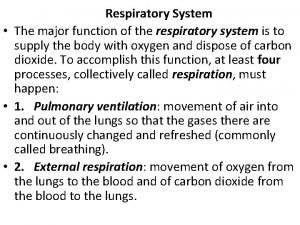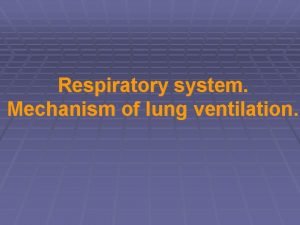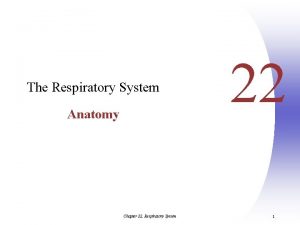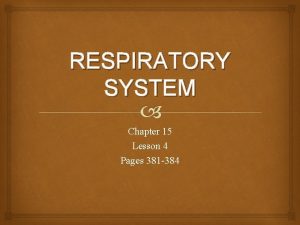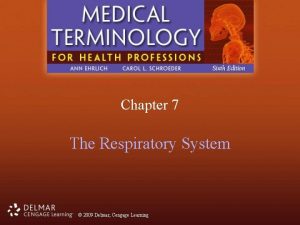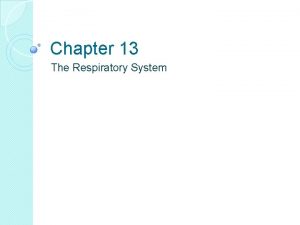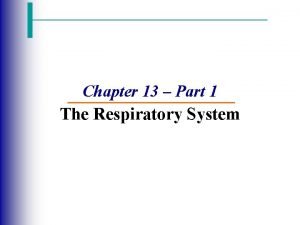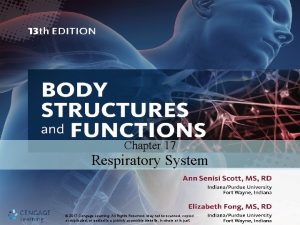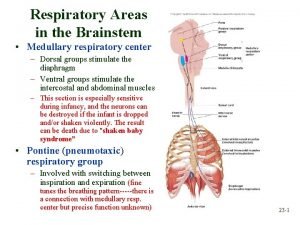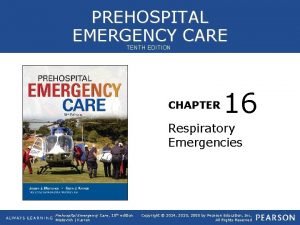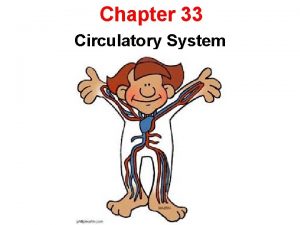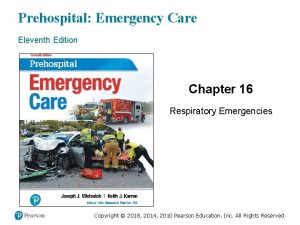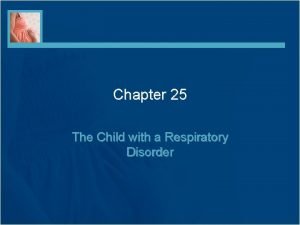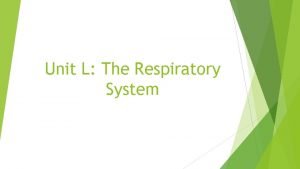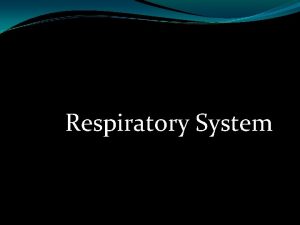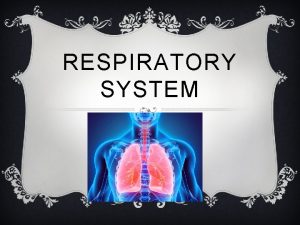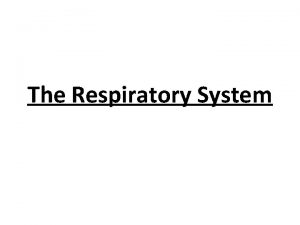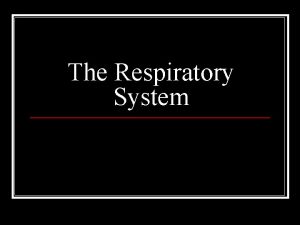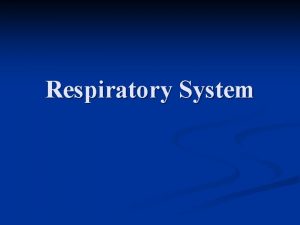Respiratory System Chapter 5 Respiratory System n Function





















- Slides: 21

Respiratory System Chapter 5

Respiratory System n Function: ¨ Takes oxygen from the air ¨ Places it in the bloodstream ¨ Removes carbon dioxide

Respiratory System n Structures ¨ Nose lined with mucous membrane and fine hairs ¨ acts as a filter ¨ moistens and warm the entering air ¨

Respiratory System n Structures ¨Nostrils n Large ¨Nasal amounts of air Chamber ¨Mouth n Brings in air

Respiratory System n Structures ¨Pharynx n Passageway for ¨Food ¨Water ¨Air ¨Controlled by epiglottis

Respiratory System n Structures ¨ Epiglottis n flap of cartilage that automatically covers the opening of the larynx during swallowing and keeps food from entering the larynx

Respiratory System n Larynx ¨Voice box (Adam’s apple) ¨Prevents material from entering lungs. n Trachea ¨Large tube ¨Made of rigid cartilaginous rings

Respiratory System n Bronchi ¨Branch out further n Lungs ¨Gas exchange

Respiratory System n Bronchi: two branches from the trachea, which conducts air into the lungs, where it divides and subdivides (referred to as a bronchial tree). ¨ bronchioles: smallest subdivision of the bronchial tree n Alveolus: air sacs at the end of the bronchioles n oxygen and carbon dioxide are exchanged through alveolar walls and capillaries

Respiratory System n Alveoli ¨ Surrounded by blood vessels ¨ Carbon dioxide is removed from blood ¨ Oxygen is absorbed into blood

Respiratory System n Lungs: 2 sponge-like organs in the thoracic cavity ¨ pleura: membrane covering each lung and lining the thoracic cavity

Respiratory System n Diaphragm ¨ Large muscle under the lungs ¨ When contracted, rib cage expands and air comes in ¨ When the diaphragm relaxes, air is forced out

Mechanisms of Breathing n Inspiration ¨ Air taken into the lungs ¨ Chest volume increase n n Intercostal muscles (between the ribs) contract to raise the ribs Diaphragm contracts towards the abdomen ¨ Pressure on lungs lowers>allows air to flow in

Mechanisms of Breathing n Expiration ¨ Forces air out ¨ Chest volume decreases n n n Intercostal muscles relax, ribs lower Diaphragm relaxes, arches towards chest Elastic tissues recoil & air is pushed out

Normal Respiration Rates Animal Cat Dog Sheep Rate (bpm) 26 22 19 Cow Horse Human Guinea Pig Hamster 30 12 12 90 74

Mechanisms of Breathing Brain controls the normal rate of respiration n Many factors influence rate: n ¨ Temperature ¨ Stress ¨ Activity ¨ Carbon Dioxide

Mechanisms of Breathing n Carbon Dioxide ¨ When muscles are active, release more CO 2 ¨ Receptors detect increase in CO 2 ¨ Brain signals for faster respiration ¨ Bronchioles dilate so more air to the alveoli

Mechanisms of Breathing n Small changes in CO 2 change respiration rate n Oxygen levels don’t influence unless they fall very low

Clinical Practice n Cyanosis ¨ When oxygen levels fall too low, blood gets much darker, and looks blue through tissue

Clinical Practice Pneumonia: inflammation in the lungs n Usually caused by bacterial or viral infection n

Clinical Practice n Heaves ¨ Disease in horses ¨ Confused with pneumonia, but not infectious ¨ Begins slowly and is long-lasting ¨ Coughing, nasal discharge, labored breathing, tire easily
 Respiratory zone vs conducting zone
Respiratory zone vs conducting zone Respiratory digestive and circulatory system
Respiratory digestive and circulatory system What is the major function of the respiratory system
What is the major function of the respiratory system Respiratory zone and conducting zone
Respiratory zone and conducting zone Voice box in respiratory system
Voice box in respiratory system Chapter 7 cengage
Chapter 7 cengage Bronchide
Bronchide Respiratory system
Respiratory system Chapter 15 lesson 2 the respiratory system answer key
Chapter 15 lesson 2 the respiratory system answer key Chapter 7 the respiratory system labeling exercises
Chapter 7 the respiratory system labeling exercises Chapter 34 section 1 the circulatory system
Chapter 34 section 1 the circulatory system Chapter 13 respiratory system
Chapter 13 respiratory system Respiratory tree divisions
Respiratory tree divisions Chapter 17 respiratory system workbook answers
Chapter 17 respiratory system workbook answers How respiratory system work with circulatory system
How respiratory system work with circulatory system Circulatory system and respiratory system work together
Circulatory system and respiratory system work together Medullary centres
Medullary centres Chapter 16 respiratory emergencies
Chapter 16 respiratory emergencies Chapter 33 section 1 the circulatory system
Chapter 33 section 1 the circulatory system Chapter 16 respiratory emergencies
Chapter 16 respiratory emergencies The child with a respiratory disorder chapter 25
The child with a respiratory disorder chapter 25 Bozeman respiratory system
Bozeman respiratory system


